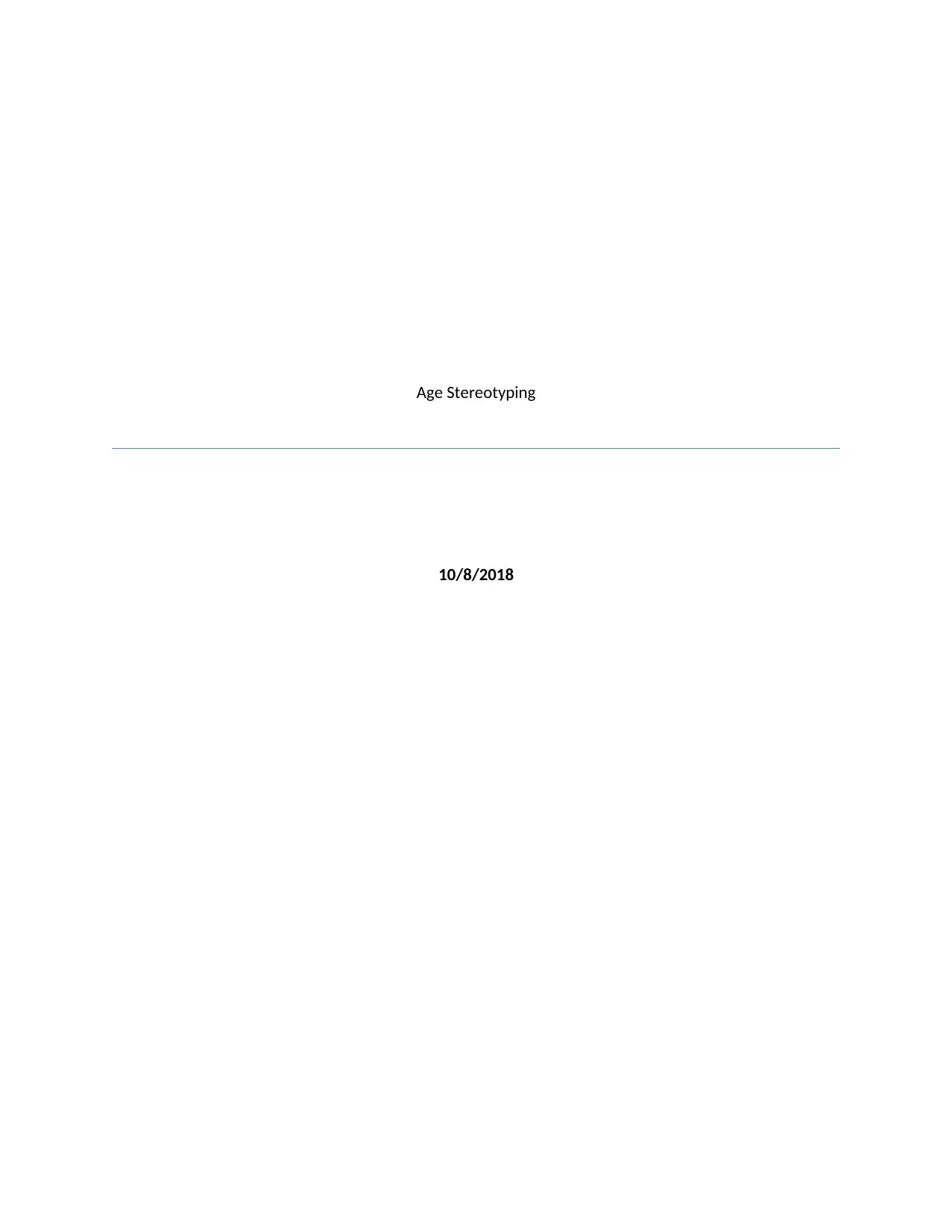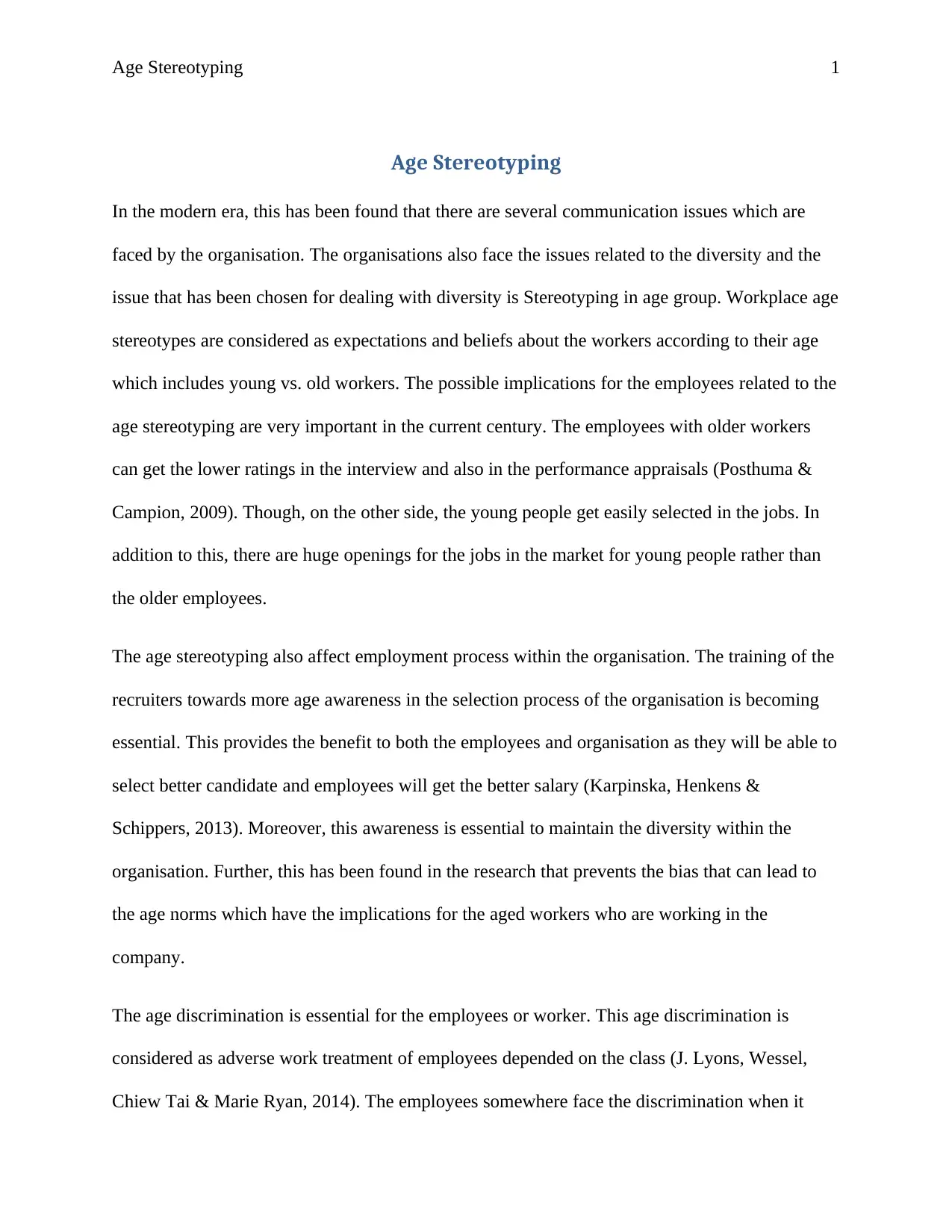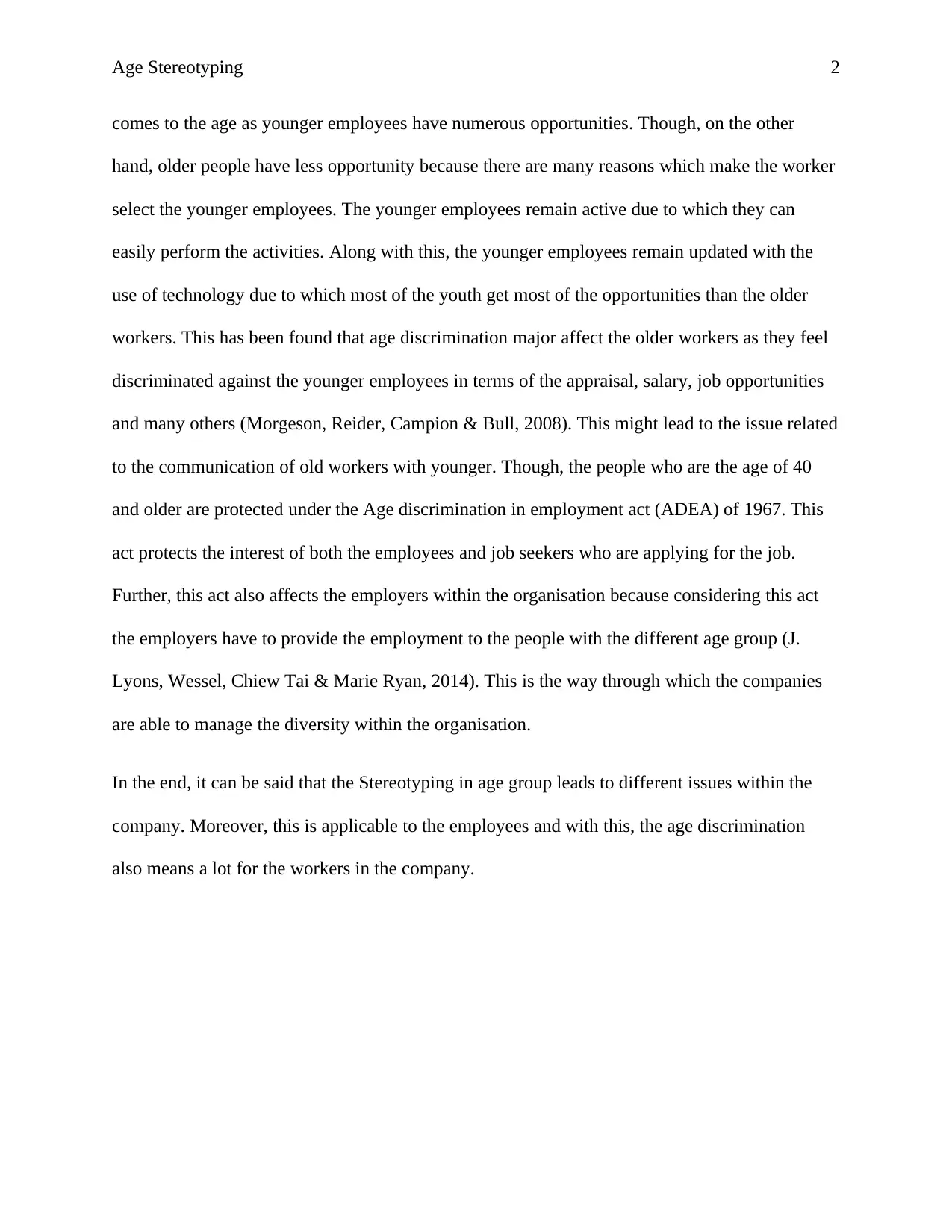Analyzing Age Stereotyping: Implications, Discrimination, and Impact
VerifiedAdded on 2023/06/04
|4
|816
|358
Essay
AI Summary
This essay discusses the implications of age stereotyping in the modern workplace, focusing on the expectations and beliefs about workers based on their age. It highlights how older workers may face lower ratings in interviews and performance appraisals, while younger individuals often have more job opportunities. The essay also addresses the impact of age discrimination, particularly on older workers, and references the Age Discrimination in Employment Act (ADEA) of 1967, which aims to protect employees and job seekers aged 40 and older. Ultimately, the essay concludes that age stereotyping can lead to various issues within a company, affecting both employees and the overall diversity of the organization.

Age Stereotyping
10/8/2018
10/8/2018
Paraphrase This Document
Need a fresh take? Get an instant paraphrase of this document with our AI Paraphraser

Age Stereotyping 1
Age Stereotyping
In the modern era, this has been found that there are several communication issues which are
faced by the organisation. The organisations also face the issues related to the diversity and the
issue that has been chosen for dealing with diversity is Stereotyping in age group. Workplace age
stereotypes are considered as expectations and beliefs about the workers according to their age
which includes young vs. old workers. The possible implications for the employees related to the
age stereotyping are very important in the current century. The employees with older workers
can get the lower ratings in the interview and also in the performance appraisals (Posthuma &
Campion, 2009). Though, on the other side, the young people get easily selected in the jobs. In
addition to this, there are huge openings for the jobs in the market for young people rather than
the older employees.
The age stereotyping also affect employment process within the organisation. The training of the
recruiters towards more age awareness in the selection process of the organisation is becoming
essential. This provides the benefit to both the employees and organisation as they will be able to
select better candidate and employees will get the better salary (Karpinska, Henkens &
Schippers, 2013). Moreover, this awareness is essential to maintain the diversity within the
organisation. Further, this has been found in the research that prevents the bias that can lead to
the age norms which have the implications for the aged workers who are working in the
company.
The age discrimination is essential for the employees or worker. This age discrimination is
considered as adverse work treatment of employees depended on the class (J. Lyons, Wessel,
Chiew Tai & Marie Ryan, 2014). The employees somewhere face the discrimination when it
Age Stereotyping
In the modern era, this has been found that there are several communication issues which are
faced by the organisation. The organisations also face the issues related to the diversity and the
issue that has been chosen for dealing with diversity is Stereotyping in age group. Workplace age
stereotypes are considered as expectations and beliefs about the workers according to their age
which includes young vs. old workers. The possible implications for the employees related to the
age stereotyping are very important in the current century. The employees with older workers
can get the lower ratings in the interview and also in the performance appraisals (Posthuma &
Campion, 2009). Though, on the other side, the young people get easily selected in the jobs. In
addition to this, there are huge openings for the jobs in the market for young people rather than
the older employees.
The age stereotyping also affect employment process within the organisation. The training of the
recruiters towards more age awareness in the selection process of the organisation is becoming
essential. This provides the benefit to both the employees and organisation as they will be able to
select better candidate and employees will get the better salary (Karpinska, Henkens &
Schippers, 2013). Moreover, this awareness is essential to maintain the diversity within the
organisation. Further, this has been found in the research that prevents the bias that can lead to
the age norms which have the implications for the aged workers who are working in the
company.
The age discrimination is essential for the employees or worker. This age discrimination is
considered as adverse work treatment of employees depended on the class (J. Lyons, Wessel,
Chiew Tai & Marie Ryan, 2014). The employees somewhere face the discrimination when it

Age Stereotyping 2
comes to the age as younger employees have numerous opportunities. Though, on the other
hand, older people have less opportunity because there are many reasons which make the worker
select the younger employees. The younger employees remain active due to which they can
easily perform the activities. Along with this, the younger employees remain updated with the
use of technology due to which most of the youth get most of the opportunities than the older
workers. This has been found that age discrimination major affect the older workers as they feel
discriminated against the younger employees in terms of the appraisal, salary, job opportunities
and many others (Morgeson, Reider, Campion & Bull, 2008). This might lead to the issue related
to the communication of old workers with younger. Though, the people who are the age of 40
and older are protected under the Age discrimination in employment act (ADEA) of 1967. This
act protects the interest of both the employees and job seekers who are applying for the job.
Further, this act also affects the employers within the organisation because considering this act
the employers have to provide the employment to the people with the different age group (J.
Lyons, Wessel, Chiew Tai & Marie Ryan, 2014). This is the way through which the companies
are able to manage the diversity within the organisation.
In the end, it can be said that the Stereotyping in age group leads to different issues within the
company. Moreover, this is applicable to the employees and with this, the age discrimination
also means a lot for the workers in the company.
comes to the age as younger employees have numerous opportunities. Though, on the other
hand, older people have less opportunity because there are many reasons which make the worker
select the younger employees. The younger employees remain active due to which they can
easily perform the activities. Along with this, the younger employees remain updated with the
use of technology due to which most of the youth get most of the opportunities than the older
workers. This has been found that age discrimination major affect the older workers as they feel
discriminated against the younger employees in terms of the appraisal, salary, job opportunities
and many others (Morgeson, Reider, Campion & Bull, 2008). This might lead to the issue related
to the communication of old workers with younger. Though, the people who are the age of 40
and older are protected under the Age discrimination in employment act (ADEA) of 1967. This
act protects the interest of both the employees and job seekers who are applying for the job.
Further, this act also affects the employers within the organisation because considering this act
the employers have to provide the employment to the people with the different age group (J.
Lyons, Wessel, Chiew Tai & Marie Ryan, 2014). This is the way through which the companies
are able to manage the diversity within the organisation.
In the end, it can be said that the Stereotyping in age group leads to different issues within the
company. Moreover, this is applicable to the employees and with this, the age discrimination
also means a lot for the workers in the company.
⊘ This is a preview!⊘
Do you want full access?
Subscribe today to unlock all pages.

Trusted by 1+ million students worldwide

Age Stereotyping 3
References
J. Lyons, B., L. Wessel, J., Chiew Tai, Y., & Marie Ryan, A. (2014). Strategies of job seekers
related to age-related stereotypes. Journal of Managerial Psychology, 29(8), 1009-1027.
Karpinska, K., Henkens, K., & Schippers, J. (2013). Hiring retirees: impact of age norms and
stereotypes. Journal of Managerial Psychology, 28(7/8), 886-906.
Morgeson, F. P., Reider, M. H., Campion, M. A., & Bull, R. A. (2008). Review of research on
age discrimination in the employment interview. Journal of Business and
Psychology, 22(3), 223-232.
Posthuma, R. A., & Campion, M. A. (2009). Age stereotypes in the workplace: Common
stereotypes, moderators, and future research directions. Journal of management, 35(1),
158-188.
References
J. Lyons, B., L. Wessel, J., Chiew Tai, Y., & Marie Ryan, A. (2014). Strategies of job seekers
related to age-related stereotypes. Journal of Managerial Psychology, 29(8), 1009-1027.
Karpinska, K., Henkens, K., & Schippers, J. (2013). Hiring retirees: impact of age norms and
stereotypes. Journal of Managerial Psychology, 28(7/8), 886-906.
Morgeson, F. P., Reider, M. H., Campion, M. A., & Bull, R. A. (2008). Review of research on
age discrimination in the employment interview. Journal of Business and
Psychology, 22(3), 223-232.
Posthuma, R. A., & Campion, M. A. (2009). Age stereotypes in the workplace: Common
stereotypes, moderators, and future research directions. Journal of management, 35(1),
158-188.
1 out of 4
Related Documents
Your All-in-One AI-Powered Toolkit for Academic Success.
+13062052269
info@desklib.com
Available 24*7 on WhatsApp / Email
![[object Object]](/_next/static/media/star-bottom.7253800d.svg)
Unlock your academic potential
Copyright © 2020–2025 A2Z Services. All Rights Reserved. Developed and managed by ZUCOL.





